Senate Armed Services Committee
-
- U.S. NAVY SHIPBUILDING PROGRAM Maritime Reporter, Aug 15, 1984 #44
Fourth Update — Changes As Of July 1984 Excerpted from a report published by International Maritime Associates, Inc.
This is the fourth in a series of reports detailing the latest changes in the United States Navy shipbuilding program. The first report appeared in the November 15, 1983 issue of MARITIME REPORTER, the second in the February 1, 1984 issue, and the third in the June 1, 1984 issue. The following reflects changes which have occurred since the publication of the third article.
International Maritime Associates, Inc. (IMA) is a management consulting firm. IMA provides market and financial analyses, assists in developing marketing strategy, and works with firms to implement specific programs in the maritime and naval markets. Assignments have been performed for shipbuilding and ship repair firms, equipment manufacturers and shipowners in the United States and fifteen foreign countries. Clients include M.A.N.-B&W Diesel, Grumman Aerospace, Todd Shipyards, National Intergroup, Allis-Chalmers, Lips Propellers, and several Scandinavian shipowners. For additional information contact James R. McCaul, International Maritime Associates, Inc., 1800 K Street, N.W., Washington, D C. 20006. Telephone (202) 296-4615 or telex 64325.
This final update to our report on the Navy shipbuilding program is divided into four sections: legislative action, developments in the shipbuilding program, changes in procurement rules, and Navy contracts awarded since January. It includes information available as of 27 June 1984.
I. LEGISLATIVE ACTION Congress has been reviewing the FY 1985 defense budget request over the past three months.
Most attention has focused on the MX missile, troop positioning in Europe, testing of antisatellite weapons and deployment of nuclear armed cruise missiles at sea.
The ship procurement budget has passed through Congress with relatively little debate.
FY 1985 Budget To Provide For Procurement Of 27 New Ships Or Conversions On 19 April the House Armed Services Committee submitted its report (H.R. 98-691) on FY 1985 defense authorizations. It recom- mended authorization for defense programs totalling $294.8 billion— $18.6 billion below the $313.4 requested by the Administration.
The Committee cut $10 billion from the proposed defense procurement budget. Program authorization was passed by the House on 31 May (298 to 98).
In response to the budget deficit, the Administration sent a revised defense budget request to Congress at the beginning of May. It contained $14.4 billion in reductions— lowering the defense budget request to $299.0 billion. The revised budget request cut $811 million from Navy ship procurement.
This reduction was achieved by eliminating an attack submarine and the T-AK resupply ship from the FY 1985 budget.
The Senate Armed Services Committee on 31 May submitted its defense authorization report (S.98-500). It recommended authorizing programs totalling $299.0 billion—$14.4 billion below the original budget request. While the same total as the Administration's amended budget request, the composition is different. The Senate Committee recommended authorization for four attack submarines (as originally requested) but removed the T-AK and one T-AGOS from the program. Program authorization was passed by the Senate on 20 June (82 to 6).
Exhibit I summarizes the Navy ship procurement program as requested by the Administration and passed by House and Senate.
Senate Armed Services Committee Recommended That Army Restrict Procurement Of Four Logistics Support Vessels (LSV) To Domestic Sources The LSV is to be a 12 knot, 2,000 ton capacity vessel used by the Army to haul cargo to remote locations and be used in the overthe- shore operations. Army had received $28.5 billion appropriation in FY 1984 to initiate this program. As there is no domestic source restriction imposed on Army procurement, the program was to be open to worldwide competition.
The standard buy American test (see IMA's June 83 report, pp. 92- 94) would apply, except to sources in countries having memoranda of understanding with the U.S.
On 6 March the LSV solicitation was made available to interested firms. Various foreign yards were interested in bidding. Under pressure from U.S. shipyards, Army decided to withdraw the solicitation until the procurement sourcing regulation is clarified.
In recommending the $18.8 million authorization for FY 1985 the committee stated: "The committee does not believe that procurement of LSV's from foreign sources is consistent with the intent of Section 7309 of Title 10, United States Code, enacted by the Congress during consideration of the Department of Defense Authorization Act, 1983. In an effort to preserve adequate U.S. shipbuilding capacity, this section bars the Navy from buying ships from foreign shipyards unless the President determines that it is in the interest of the national security to do so.
The committee believes that the Congress intended that all military vessels, not just "naval vessels," be covered by the restriction. To clarify this issue, the committee recommends bill language that expands the scope of Section 7309 of Title 10 to cover all military vessels." Senate Recommended T-AO 187 Program Be Opened To Second Source Competition Senate Armed Services Committee recommended that the Navy seriously consider establishing a second source for the TAO fleet oiler program. Avondale has received contracts for four of these ships. Three are authorized for FY 1985. According to NAVSEA, Navy's plan is to open the next flight of T-AO's to industrywide competition.
Senate Recommended Engines Be Competed In Future T-AO's Colt-Pielstick was chosen to supply diesel prime movers for the first four T-AO fleet oilers. The Senate Armed Services Committee has recommended that Navy seek to compete the engine contract for follow-on requirements. This competition is to be held within "the funding constraints that exist within current Navy planning for follow-on engines." Allis-Chalmers— M.A.N./B&W diesel and DeLaval-Stork Werkspoor were the two competitors to Colt-Pielstick in the original T-AO engine competition.
According to NAVSEA, Navy will require that competing engines be manufactured in this country. This will present difficulty to diesel manufacturers wishing to compete—as Colt has already received a sizable technology transfer grant to tool up for domestic manufacture. Other companies will need to make an investment in facilities. Seems unfair!
House Cancelled FFG Funded Last Year And Reprogrammed Funds For FY 1985 Trident Procurement The House Committee recommended cancellation of the FFG frigate placed in the SCN procurement program by Congress last year (see IMA's first update—excerpted November 15, 1983 MR/ EN). Funds previously appropriated ($300 million) would be transferred to the FY 1985 Trident program. Navy had advised the Committee that the FFG with improvements specified for the FY 1984 ship would cost $473 million—$ 173 million over the original estimate.
This action was not taken by Senate and the subject will be taken up by conferees.
Todd in its 1 April 1984 Annual Report states "the Los Angeles Division expects to receive a contract shortly for an additional FFG . . ." This contract is projected to add $100 million to Todd's backlog.
Cancellation of the ship will hurt!
Provision For Cost Growth In FY 1985 Procurement Has Been Eliminated The original Administration budget request provided $187 for potential cost growth to offset program cost increases beyond Navy control. Both House and Senate eliminated this budget item. The Administration also eliminated it from the amended request in May.
Reason given for this action is the continuing success in staying within budget.
House And Senate Conferees Have Been Meeting To Work Out Differences Between The Two Bills For ship procurement the difference between the House and Senate authorization bills are relatively minor: • Senate has authorized more funds than House for BB 63 Missouri reactivation • There is a small difference in funding level for the 2 TAGOS's • Senate added $25 million to repricing and deleted $3.5 million in contractor support • House has cancelled FFG authorized in FY 1984 and transferred funds to Trident program; Senate has not taken this action The conference report will be sent to both House and Senate for vote, presumably before Congress adjourns for July recess.
2. DEVELOPMENTS IN SHIPBUILDING PROGRAM As of June 1984 only two FY 1984 shipbuilding contracts are still to be awarded: the lead MSH and one FFG. The former is scheduled to be awarded to either Bell- Halter or Marinette Marine around mid-August. The latter will be awarded to either Todd-Los Angeles or Bath, provided it is not cancelled.
95 SCN-Funded Navy Ships Are On Order As Of Mid-June Exhibit 2 lists current Navy new construction or conversions, by shipyard. The dates for starting construction and scheduled delivery are shown. Ships being procured via long term charter (5 T-5 tankers and 13 T-AKX RO-RO ships) are not included in this list.
About One Third Of The FY 1985 Programs Will Be Open To Industrywide Competition Five of the 16 programs (LPD-4, T-AGOS, T-AO T-AGS, T-ACS) will be open to industrywide competition.
One program (LCAC) will probably be opened to second source competition. Competition in these programs (SSN, CG-47, MCM) will be limited to current players. Contractors for four programs (TRIDENT, LSD-41, LHD-1, T-AVB) are already known. Two programs (BB, CV-SLEP) are to be accomplished in naval shipyards.
Exhibit 3 summarizes the procurement picture for next year.
Greatest uncertainty surrounds the DDG-51 award. Three yards are competing for the lead ship contract. Ingalls has probably the greatest recent experience building surface combatants, being lead yard for the DD-963 class destroyer and the CG-47 class cruiser.
Bath has been lead yard for the FFG-7 class frigate and follow yard for the CG-47 class cruiser.
Todd-L.A. has been follow yard for the FFG-7 frigate. Recent experience favors Ingalls and Bath. Political considerations and need for work favor Todd-L.A.
Schedule for award of DDG-51 follows: • issue formal solicitation July 1984 • proposals due September 1984 • award December 1984 • ship commissioning July 1989 A draft solicitation was sent to the shipyards on 30 March.
Design Proposals For New Attack Submarine Due By Year End Navy plans to receive proposals from Newport News and GD-Electric Boat for the new attack submarine intended to replace the Los Angeles -class submarine.
Proposals are scheduled around the end of the year. Award is planned about mid-1985 and production is to start in 1989. The lead submarine is projected to cost $1.6 billion, with follow submarines costing about $1 billion each.
3. CHANGES IN PROCUREMENT RULES Several significant developments have occurred over the past several months.
FAR and DOD FAR Supplement Has Been Published The Defense Acquisition Regulation (DAR) has been superseded by the Federal Acquisition Regulation (FAR) in an effort to coordinate and simplify federal procurement rules. A special DOD supplement to the FAR contains regulations which apply only to defense procurement.
Many forms used in DOD contracting have been changed or eliminated. A cross reference guide for old vs. new forms is contained in Part 53 of the DOD FAR supplement.
A Federal Acquisition Circular will be periodically issued to publicize revisions to the FAR.
Each Of The Services Has Been Ordered To Coordinate Purchasing Of Parts As a result of the continuing issue of spare parts overcharges, Secretary Weinberger has ordered Navy, Army and Air Force to work together to buy parts jointly in large lots. The order also requires that companies sell parts to DOD at prices equal to or below prices charged their best customers.
The General Accounting Office (GAO) Has Issued Policy Review Of Military Sales Offsets DOD has estimated that about $30 billion in potential arms sales over the next five years will involve offset arrangements. (See IMA June 83 report, pp. 103-108 for description of offsets). At request of House Committee on Banking, Finance and Urban Affairs, GAO has reviewed current policy on offset arrangements. It concluded no overall policy exists, there is little coordination among federal agencies, and no agency has taken the lead to protect U.S.
economic interests. GAO specifically recommended that Congress consider directing that offset demands by foreign governments be resisted when FMS credits or grants are involved in the sale.
This report "Trade Offsets in Foreign Military Sales," GAO/ NSIAD-84-102 can be obtained by contacting U.S. General Accounting Office, Document Handling and Information Service Facility, P.O. Box 6015, Gaithersburg, MD 20760, Telephone (202) 275-6241.
4. CONTRACTS Exhibit 4 lists major Navy contracts awarded between 1 April and 27 June as announced by the Department of Defense and published in the Wall Street Journal.
The list is not comprehensive, but has been arranged to include contracts for ships, systems, weapons, and services. Aircraft related contracts are not included.
-
- U.S. NAVY OVERHAUL MARKET Maritime Reporter, Jul 16, 1985 #24
a comparison of the work planned to be accomplished during the SLEP with the work identified as being required in the "AIRPAC Study." The Senate Armed Services Committee requested that Navy certify the cost effectiveness of its plan and placed limits on use of funds until the certification is provided: The
-
- Unique U.S. Navy Minehunter, First Of New MHC Class, Launched At Intermarine USA Maritime Reporter, May 1991 #50
a technology transfer arrangement between Italian and U.S. authorities. Among the dignitaries in attendance were Senator Sam Nunn, Chairman of the Senate Armed Services Committee; Senator Wyche Fowler, Member of the Senate Appropriations Committee; U.S Representative Lindsay Thomas; Secretary of
-
- Ship Repair Yards Ask: Where's the Funding? Maritime Reporter, Mar 2000 #26
at $2.5 billion, these backlogs are expected to climb to $4 billion over the next few years. In 1998, the loint Chiefs of Staff to the Senate Armed Services Committee dispensed a warning per the declining state of military readiness, which obviously has not made its mark with the Navy — despite dangerous
-
- Prefabrication of Federal Shipbuilding Project Funding Marine News, Sep 2021 #20
program’s multi-year procurement contract, which adversely impacts the already fragile domestic shipbuilding industrial base.” The Senate Armed Services Committee apparently shares the views of House appropriators, adding $1.7 billion in its markup of the FY 2022 National Defense Authorization Act
-
- US Mid-term Elections Bring Changes, Uncertainty in Congressional Maritime Leadership Marine News, Nov 2022 #18
Ranking Member Sen. Roger Wicker (R-Miss.) will be departing the committee to assume the role of either Chair or Ranking Member of the Senate Armed Services Committee (SASC). Sen. Wicker previously served as a Chair of Senate Commerce prior to the 2020 election, having assumed the role from Sen. John
-
- AWO Working Hard for the Domestic Workboat Market Maritime Reporter, Aug 2015 #22
.S. fleet?” General Paul Selva, then Commander of the U.S. Transportation Command and now Vice Chairman of the Joint Chiefs of Staff, told the Senate Armed Services Committee that “The Jones Act contributes to a robust domestic maritime industry that helps to maintain the U.S. industrial shipyard base and infrastruct
-
- U.S. Navy: DDG(X) is a Large Surface Combatant with Room to Grow Maritime Reporter, Feb 2022 #34
the capacity necessary to deter China and do the other things that we need to do,” before the DDG(X)s are delivered.Congress may agree. The Senate Armed Services Committee said in a report accompanying the National Defense Authorization Act for Fiscal Year 2022 that the DDG-51 destroyers are the backbone
-
- THE $34-BILLION ANNUAL U.S. NAVY MARKET Maritime Reporter, Jun 1988 #24
one SWATH-design AGOR research ship. The committee recommended against this funding on the basis the design was not fully developed. The Senate Armed Services Committee bill completed mark up in late April— and the Senate bill essentially similar to the House version. Both the House and the Senate must
-
- The 92nd SNAME Annual Meeting A Special Post-Meeting And Exposition Report Maritime Reporter, Dec 15, 1984 #18
support my thesis I would like to comment on a recent Congressional Budget Office study. This study, prepared at the request of the Senate Armed Services Committee, concludes: 'without government assistance or other reforms, ships operating under U.S. flag and shipyards here, long considered important
-
- The OPC Sweepstakes: Three for the Money Marine News, May 2014 #36
good jobs in Maine, they said. Collins is a senior member of the Senate Defense Appropriations Subcommittee, and King is a member of the Senate Armed Services Committee. Bath is known for building quality vessels that last. Bath’s USCG cutter Perseus, launched in 1932, sailed for 76 years. The boat was
-
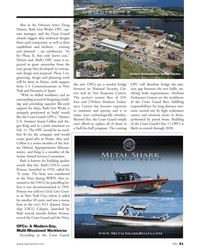 )
May 2014 - Marine News page: 41
)
May 2014 - Marine News page: 41jobs in Maine, they said. Collins is a senior member of the Sen- ate Defense Appropriations Subcom- mittee, and King is a member of the Senate Armed Services Committee. Bath is known for building quality vessels that last. Bath’s USCG cutter Perseus, launched in 1932, sailed for 76 years. The boat
-
 )
May 2014 - Marine News page: 41
)
May 2014 - Marine News page: 41jobs in Maine, they said. Collins is a senior member of the Sen- ate Defense Appropriations Subcom- mittee, and King is a member of the Senate Armed Services Committee. Bath is known for building quality vessels that last. Bath’s USCG cutter Perseus, launched in 1932, sailed for 76 years. The boat
-
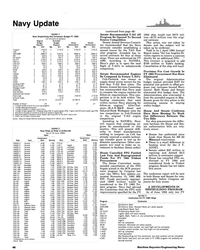 )
August 15, 1984 - Maritime Reporter and Engineering News page: 46
)
August 15, 1984 - Maritime Reporter and Engineering News page: 46Be Competed In Future T-AO's Colt-Pielstick was chosen to supply diesel prime movers for the first four T-AO fleet oilers. The Senate Armed Services Committee has recommended that Navy seek to compete the engine contract for follow-on requirements. This com- petition is to be held within
-
 )
March 2000 - Maritime Reporter and Engineering News page: 26
)
March 2000 - Maritime Reporter and Engineering News page: 26$2.5 billion, these backlogs are expected to climb to $4 bil- lion over the next few years. In 1998, the loint Chiefs of Staff to the Senate Armed Services Committee dis- pensed a warning per the declining state of military readiness, which obviously has not made its mark with the Navy — despite
-
 )
June 2012 - Maritime Reporter and Engineering News page: 36
)
June 2012 - Maritime Reporter and Engineering News page: 36counted?up from 274 in March of 2007?but that number will still be 288 five years from now. However, Secretary of the Navy Ray Mabus told the Senate Armed Services Committee hearing on the Proposed Fis-cal 2013 Defense Authorization, the ?fleet of 2017 will include more more-ca-pable ships equipped with state-of-the
-
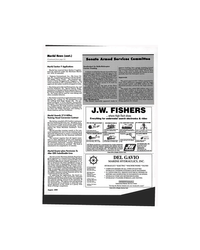 )
August 1994 - Maritime Reporter and Engineering News page: 57
)
August 1994 - Maritime Reporter and Engineering News page: 57MarAd News (cont.) Senate Armed Services Committee MarAd Section 9 Applications MarAd has received three Section 9 applica- tions for approval under the Merchant Marine Act, 1916, as amended: • Neptune International, Inc., Elk Grove Vil- lage, 111., requested permission to sell the 40,631- dwt
-
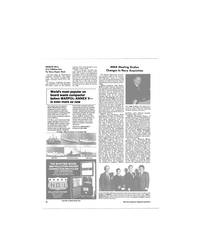 )
December 1988 - Maritime Reporter and Engineering News page: 32
)
December 1988 - Maritime Reporter and Engineering News page: 32Parts Control Center: Capt. Wayne I. Humphreys, USN, Chief of Staff, Commission on Merchant Marine and Defense; Senator William S. Cohen, Senate Armed Services Committee; and James P. Fromfield, president, Marine Machinery Association. 36 Circle 264 on Reader Service Card Maritime Reporter/Engineering
-
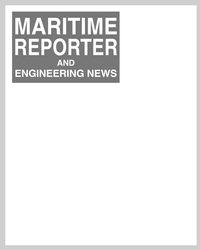 )
June 2009 - Maritime Reporter and Engineering News page: 39
)
June 2009 - Maritime Reporter and Engineering News page: 39appropriate security measures to protect themselves from pirates," said Michele Flournoy, undersecretary of defense for policy, speaking to a Senate Armed Services Committee hearing. "We will continue to respond when U.S.-flagged vessels and U.S. citizens are attacked by pirates," Flournoy continued. "But when
